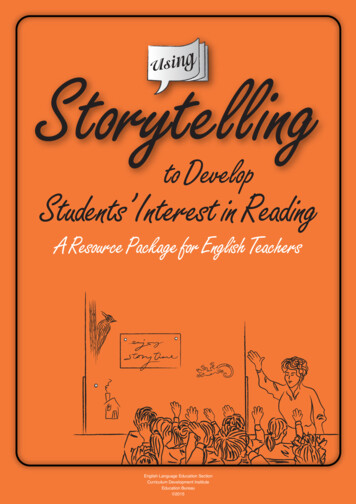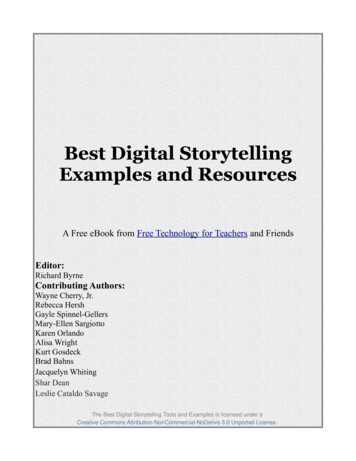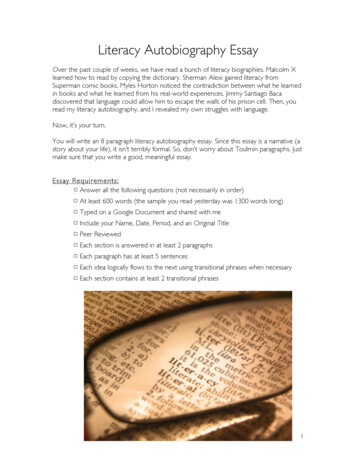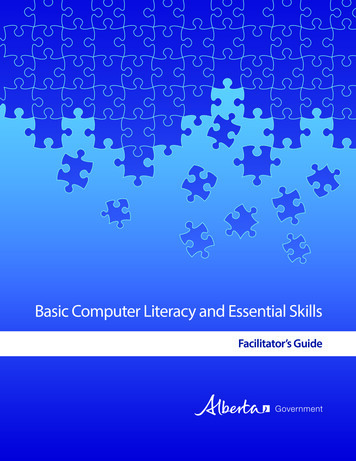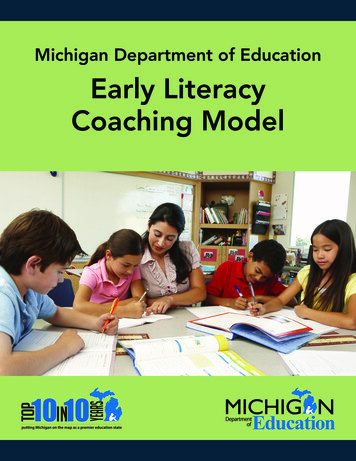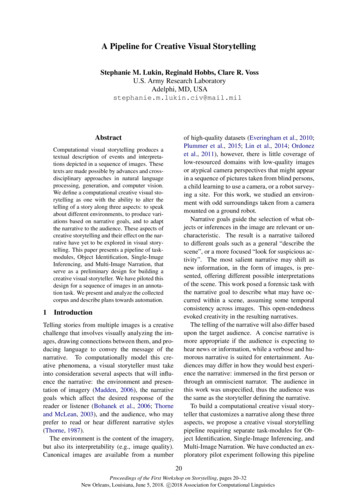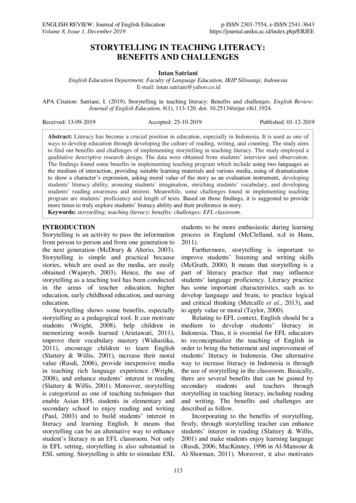
Transcription
ENGLISH REVIEW: Journal of English EducationVolume 8, Issue 1, December 2019p-ISSN 2301-7554, e-ISSN EESTORYTELLING IN TEACHING LITERACY:BENEFITS AND CHALLENGESIntan SatrianiEnglish Education Department, Faculty of Language Education, IKIP Siliwangi, IndonesiaE-mail: intan.satriani@yahoo.co.idAPA Citation: Satriani, I. (2019). Storytelling in teaching literacy: Benefits and challenges. English Review:Journal of English Education, 8(1), 113-120. doi: 10.25134/erjee.v8i1.1924.Received: 13-09-2019Accepted: 25-10-2019Published: 01-12-2019Abstract: Literacy has become a crucial position in education, especially in Indonesia. It is used as one ofways to develop education through developing the culture of reading, writing, and counting. The study aimsto find out benefits and challenges of implementing storytelling in teaching literacy. The study employed aqualitative descriptive research design. The data were obtained from students’ interview and observation.The findings found some benefits in implementing teaching program which include using two languages asthe medium of interaction, providing suitable learning materials and various media, using of dramatizationto show a character’s expression, asking moral value of the story as an evaluation instrument, developingstudents’ literacy ability, arousing students’ imagination, enriching students’ vocabulary, and developingstudents’ reading awareness and interest. Meanwhile, some challenges found in implementing teachingprogram are students’ proficiency and length of texts. Based on those findings, it is suggested to providemore times to truly explore students’ literacy ability and their preference in story.Keywords: storytelling; teaching literacy; benefits; challenges; EFL classroom.INTRODUCTIONStorytelling is an activity to pass the informationfrom person to person and from one generation tothe next generation (McDrury & Alterio, 2003).Storytelling is simple and practical becausestories, which are used as the media, are easilyobtained (Wajnryb, 2003). Hence, the use ofstorytelling as a teaching tool has been conductedin the areas of teacher education, highereducation, early childhood education, and nursingeducation.Storytelling shows some benefits, especiallystorytelling as a pedagogical tool. It can motivatestudents (Wright, 2008), help children inmemorizing words learned (Arietawati, 2011),improve their vocabulary mastery (Widiastika,2011), encourage children to learn English(Slattery & Willis, 2001), increase their moralvalue (Rusdi, 2006), provide inexpensive mediain teaching rich language experience (Wright,2008), and enhance students’ interest in reading(Slattery & Willis, 2001). Moreover, storytellingis categorized as one of teaching techniques thatenable Asian EFL students in elementary andsecondary school to enjoy reading and writing(Paul, 2003) and to build students’ interest inliteracy and learning English. It means thatstorytelling can be an alternative way to enhancestudent’s literacy in an EFL classroom. Not onlyin EFL setting, storytelling is also substantial inESL setting. Storytelling is able to stimulate ESLstudents to be more enthusiastic during learningprocess in England (McClelland, n.d in Hana,2011).Furthermore, storytelling is important toimprove students’ listening and writing skills(McGrath, 2000). It means that storytelling is apart of literacy practice that may influencestudents’ language proficiency. Literacy practicehas some important characteristics, such as todevelop language and brain, to practice logicaland critical thinking (Metcalfe et al., 2013), andto apply value or moral (Taylor, 2000).Relating to EFL context, English should be amedium to develop students’ literacy inIndonesia. Thus, it is essential for EFL educatorsto reconceptualize the teaching of English inorder to bring the betterment and improvement ofstudents’ literacy in Indonesia. One alternativeway to increase literacy in Indonesia is throughthe use of storytelling in the classroom. Basically,there are several benefits that can be gained bysecondary students and teachers throughstorytelling in teaching literacy, including readingand writing. The benefits and challenges aredescribed as follow.Incorporating to the benefits of storytelling,firstly, through storytelling teacher can enhancestudents’ interest in reading (Slattery & Willis,2001) and make students enjoy learning language(Rusdi, 2006; MacKinney, 1996 in Al-Mansour &Al-Shorman, 2011). Moreover, it also motivates113
Intan SatrianiStorytelling in teaching literacy: Benefits and challengesstudents to read and improve their readingcomprehension (Scott & Ytreberg, 1990).Besides, storytelling can also be used to preparestudents to write their own stories (Scott &Ytreberg, 1990). The example of students’writing development through storytelling can beseen from students’ writing journal. In thatactivity, teacher does not only obtain the data ofstudents’ writing, but also their development ofanalytical and reasoning skills. In this case,storytelling can develop students’ writing abilityas it provides opportunities to discover someimportant dialogue and to understand stories andstory elements (Campbell & Husek, 2009).In line with literacy, storytelling promotesexpressive and receptive language development,namely written composition and readingcomprehension (Peck, 1989). Second languagelearners who share personal experiences throughstorytelling are able to demonstrate linguisticgrowth. The text of the story also provides thepotential for comprehensible input. This input canbe achieved in multi ways, for instance individualreading, a number of group sharing, groups ofstudents working on a core text and taking it indifferent directions according to their ownimaginations (Wajnryb, 2003). In increasingstudents’ novels word comprehension, vocabularyeliciting questions and noneliciting questions alsocan be used in storytelling activity (Walsh &Blewitt, 2006).Students’ interest in reading story can beenhanced when students have heard a story once.Teacher can tell the students that each time theyread a book, they will become more familiar withthe language of the story and will be able toparticipate more in different ways (Slattery &Willis, 2001). The way teachers observe readingbehavior is linked to different reader purposeswhich are linked to situational context and also tosocial expectations, for example what kind ofreading behavior is expected in classrooms,families, or particular religious’ settings (Wallace,1992).Secondly, storytelling using local legends canhelp teacher to set values and to introduce culturalidentities to the students (Pahl & Rowsell, 2005).There are different kinds of literacy practiceswithin communities, through cultural, social andeducational experiences, such as read story booksas children, read to our children as parents,communicate with distant friends or relativesthrough reading (Hood, Solomon, & Burns,2005).Third, learning literacy through storytellingcan help students to get sense or meaning of text(Metcalfe, et al., 2013). Understanding meaningof text has a relation with the comprehension ofvocabulary and grammar. In using storytelling toteach reading and writing, it can help learners touse vocabulary and grammar correctly. Learningto tell and write effective stories is an effectivelanguage learning application for students toincrease their knowledge of vocabulary andgrammar (Nicholas, Rossiter, & Abbott, 2011).Fourth, storytelling allows students toincrease their imagination (Wright, 2008). In caseof picture books, the narrative nature of picturebooks invites readers or viewers to see howartistic elements act as a form of visualcommunication. Through illustration, illustratorshows the relationship a character has with othercharacters or further extends a character’sintentions in the plot through movement,performance and gesture (Pahl & Rowsell, 2005).Needlman (2004 in Al-Mansour & Al-Shorman,2011) adds that reading aloud through storytellingcan build students’ imagination.Thus, although there are various research onstorytelling in teaching literacy, there is still lackof studies investigating the benefits andchallenges of implementing storytelling inteaching literacy. Addressing this gap, this studyfocuses on obtaining perception from students’point of view about teaching literacy throughstorytelling.METHODThis present study employed a qualitativedescriptive method. This method is used toexamine questions that can best be answered byverbally describing how participants in a studyperceive and interpret various aspect of theirenvironment (Crowl, 1996). Qualitative researchprovides opportunities for researchers to studysocial phenomena in relation to people’s everydaylives. Through a process of data interpretation,qualitative research provides information aboutwhat, why and how a phenomenon in asociety happens. This is in line with what Denzinand Lincoln (2005) say that qualitative researchalso involves an interpretive, naturalisticapproach to the world. In addition, Yin (1994)also elaborates that employing qualitative methodprovides researchers with opportunities torepresent the views and perspectives of thepeople/participants in a study.114
ENGLISH REVIEW: Journal of English EducationVolume 8, Issue 1, December 2019p-ISSN 2301-7554, e-ISSN EEThe study was undertaken at a private JuniorHigh School in Cipatat, rural part of WestBandung, West Java province, Indonesia. Theschool is a suburban school with a d families which had lowermotivation in continuing their study to senior highschool. Most of them are prefer to work after theygraduated from their junior high school.The participants of this study consisted of sixeighth grader of junior high school. They wereselected as the representative of a group which isappropriate with one of case study features(Cohen, Manion, & Morrison, 2007). The sixstudents were divided into three categories,namely two students from high levelachievement, two from middle level achievement,and two from lower level achievement based ontheir performance in previous reading lesson anddiagnostic writing. All participants were allSundanese who have Bahasa Sunda as theirmother tongue. Bahasa Indonesia is their secondlanguage. English and Arabic are thus theirforeign language.Upon the chosen steps of an observationclassroom, this study conducted a preliminaryobservation to the classroom and made aconsultation with the prior English teacher (it wastaken one term). Students attended individualinterview which run about 15 minutes and wasaudio taped. This interview attempted to find outstudents’ perceptions about the implementation ofstorytelling (the strengths, weaknesses, and whatstudents think they have obtained in theirclassroom). Prior to the interview, the researcherinformed the participants that the interview wasaudiotaped and their names was not mentioned tokeep their identity confidential.RESULTS AND DISCUSSIONThis section delineates the depiction of researchfindings of the study and the discussion dealingwith the data investigated and collected from theobservation and interview. The presentation ofthis section is divided into two sections. The firstsection discusses the benefits of theimplementation of storytelling technique indeveloping students’ literacy skill and the secondsection elaborates the challenges of implementingthe technique in teaching literacy to the students.The discussion of this teaching program isincorporated with the instruments used and theoryto support the study.Benefits of implementing storytelling inteaching literacyThis study found eight benefits of implementingstorytelling in teaching literacy. The benefitscover using two languages as the medium ofinteraction, the provision of suitable learningmaterials and various media, using dramatizationto show a character’s expression, asking moralvalue of the story as an evaluation instrument,developing students’ literacy skills, arousingstudents’ imagination, helping students to sharetheir experiences, improving students’ vocabularymastery, and increasing students’ readingawareness and interest. The aforementionedbenefits are described below.Using two languages as the medium ofinteractionBefore implementing storytelling activities, theresearcher informed the students about theteaching program. This activity was intended torealize that what is to be learnt should be madeclear to the students (Feez, 2002). The medium ofinteraction at all stages throughout the teachingprogram was English and Bahasa Indonesia. Thetwo languages were used during theimplementation of the program because of somereasons. First, Bahasa Indonesia was usedespecially when the students or the teacher founddifficulty in expressing their ideas, explaining themeaning, or discussing the main ideas in readingand writing in English (see Willis, 1981 cited inEmilia, 2010). Second, bilingualism was expectedto affect positively both students’ intellectual andlinguistic progress and allow for their greatersensitivity to linguistic meanings and moreflexibility in their thinking (Cummins, 1996 citedin Emilia, 2005). Meanwhile, the use of BahasaIndonesia was expected to avoid the silence of theclass so the students could participate actively inthe teaching program (Emilia, 2005).The provision of suitable learning materials andvarious mediaThe selection of suitable materials was consideredimportant in the teaching program especially theimplementation of storytelling. With regard to thelearning materials, this study focused on twomain materials, namely narrative text and thestories itself. Firstly, related to narrative text. Dueto narrative text is the focus of storytelling,teacher should make students aware about thecontent of the text. Students were firstlyintroduced to the description of narrative textwhich include the definition of narrative text, thesocial function of narrative text, the schematicstructure of narrative text, the language features115
Intan SatrianiStorytelling in teaching literacy: Benefits and challengesof narrative text, and the example of narrativetext.In addition, another component in learningmaterial is stories for students. Those stories wereselected based on the characteristics of the best orinteresting stories for children. Derewianka(1990) states that to introduce the author whowould be sure to grab students’ interest can beone of ways to make students love of books andenthusiasm for good children’s literature. Theselection of the stories based on several points; 1)students’ familiarity with the story; 2) the coloredpicture series of the stories; and 3) teacher’sperformance skills in telling the stories.Rahmawati (2014) suggested that it will be betterif the story is the local one with good values.Using dramatization to show a character’sexpressionThe observation data showed that the studentsenjoyed the story started from the beginning untilthe end of the story. It was because the teacherused interesting media and explained the storyexpressively. By showing and telling the storyexpressively, they seemed more motivated toknow the content of the story. In this activity, theteacher also used some dramatization to show acharacter’s expression or emotion. According toScott and Ytreberg (1990), character’s expressionor gesture can attract students’ interest incomprehending the story. During telling the story,the teacher located the storybook in the locationthat was visible by the children and movedaround so that everyone could see. It can be seenthrough students’ expression below that theycould respond to the story.T : “Look at the picture! Can the horse catch thegingerbread man?”S#3 : “No, Ibu. Gingerbread man run from horse.”student said that the moral value of the story was“we have to be honor to our mother.” The othersaid that “we must love our family like sarah,percy and bill.” Fable is s proper example offictitious story that teach moral lesson (Sherman,2008).The instrument of the evaluation used wascloze procedure. This test was chosen as testinstrument in this research because it can supportstudents’ understanding of grammar, spelling, andsentence construction (Hancock & Leaver, 2006).In line with the data, the result presented thatthrough ten questions given to the students,students showed their development. In the firstsection, their vocabulary was developed. Allstudents were able to put some proper words intothe provided boxes. Furthermore, in the secondsection, they knew what they should do, becauseit was the second time for them to meet that typeof questions. Since they are interested in thestory, they easily found the correct partner of theblank sentences.Developing students’ literacy skillBased on the data of students’ interview, it wasfound that students developed their literacycapacity and skill. The development of students’literacy skill can be seen in the following excerpt:I understand the story, because when teacher tellsthe story, she gives me a text of the story so thatwe can understand the plot of that story. (S5)(Interview, translated version)The above excerpt also showed that throughstorytelling, students can explore their writingability. McDrury and Alterio (2003) support thedata that through storytelling in the field ofeducation and teaching learning, learners can beencouraged to tell stories by their own wordsusing their complex ideas, concepts orinformation which they had obtained before.Besides, the selection of the story is importantin implementing storytelling in the classroom. Asstated by Wright (2008), through the closest storyfrom students, it can be the best activities forthem in obtaining the gist of the story. Thestatement relates with students’ perception below.Then, in the process of storytelling, theteacher invited the class to visualize thevocabulary and to understand the basicvocabulary by using TPR (total physicalresponse). The students responded thevocabularies in a physical way by carrying out theinstructions, for example “he did some gardeningand fishing in his daily life.” In addition, inI like The Ginger Bread man’s story. (S5)facilitating good visualization of the story, the(Interview, translated version)teacher displayed a huge picture in front of theThe story is easy to be understood. I understandclassroom. After that, she put up the pictures ofwith the story, because there are some interestingpictures in the book. (S3) (Interview, translatedthe characters on the board.version)Asking moral value of the story as an evaluationinstrumentStudents #1 and Student #4 understand theAt the end of the second unit, the students were story because they have good first impressionasked to think of the moral value of the story. One toward the story. Furthermore, they also have116
ENGLISH REVIEW: Journal of English EducationVolume 8, Issue 1, December 2019p-ISSN 2301-7554, e-ISSN EEprior knowledge of the story given. Related to the 2006, p.122). The previous theory is supported byliteracy, in implementation, students do not only result of student’s interview below.feel interesting and enjoyable with the story, butBefore I learn using storytelling, I did not knowalso their thinking skills can be developedwhat the meaning of that story is. Through this(Slattery & Willis, 2001, p. 96).activity, I feel my vocabulary increased. (S1)I like the part when we read using big book,because the picture is clear and big. (S5)(Interview, translated version)(Interview, translated version)The activity of telling stories can add myvocabulary, because teacher tells different kind ofstories. (S1) (Interview, translated version)In addition to the story itself, in developingstudents’ literacy skill, the media of telling storyalso should be noticed. The use of visual tools arealso important as one of supporting media thatsupports storytelling activities (Sprenger, 2010,p.101).Arousing students’ imaginationStudents in junior high school (from 13-14 yearsold) tend to enjoy some variation of story, such ascomplex story, adventure story, and romanticstory (Phillips, Burwood & Dunford, 1999;Pinter, 2006; Wright, 2008; Hana, 2011).Students need pictures, expressions, and visualtools in exploring story. Visual tools are able tofacilitate learners in understanding the meaning ofthe story. Those can also dig students’imagination, as supported by students’ perceptionbelow.Related to student one’s perception, she feltthat her vocabulary was increased throughlearning using storytelling. In the activities ofstorytelling, teacher does not only focus on thestory itself, but also he or she can focus on thespecific lesson, for example building students’vocabularies (Zaro & Salaberri, 1995, p. 9).Increasing students’ reading awareness andinterestReading is a part of daily life for people who livein literate communities that much of the time theyhardly consider either the purposes or processinvolved (Wallace, 1992, p. 5). Because ofreading is the primary to any definition of literacybefore writing, it is important for teacher to assiststudentsto beinterested in readingcomprehension.Because telling the story using gesture andexpression, the story is easy to be comprehended.This is the first time for me to know the story.First, I do not understand the meaning of the storyin English. However, because teacher tells thestory using body movements and pictures, I canimagine the story. (S1) (Interview, translatedversion)I like Babies Owl story, mam. The story is funny.The picture is big. Then, I can see big font size.The most important, I like animal story. (S2)(Interview, translated version)Learning using storytelling make me want to learnmore and to try reading and writing in English. Iam more interesting in learning English. (S1)(Interview, translated version)Incorporating with the student’s interviewresult, learning reading and writing throughstorytelling made student’s engagement inlearning increased. It is supported by Scott andYtreberg (1990, p.69; Hana, 2011, pp.15-16) whostate in teaching storytelling, teacher can integrateboth reading and writing. That is because readingand writing is the example of learningBased on the result of students interview, consolidation.Tooze (1959) supports that stories can inspireTelling stories using expression and usingstudents in developing their imagination. Theinteresting book to be read make me enjoy andselection of fable also influences students inunderstand the story. (S3) (Interview, translatedarousing their imagination. It means that studentsversion)from elementary up to secondary level put theirhuge attention to the animals characters (Pinter,Challenges of implementing storytelling in2006) or fictitious story.teaching literacyImproving students’ vocabulary masteryIn implementing storytelling in teaching literacy,In teaching vocabulary to secondary students,there were two challenges that can disturb theteachers do not only use one technique or method,effectiveness of teaching program. The challengesbut they can also apply storytelling as the mainhad something to do with students’ proficiencytechnique in increasing students’ vocabularyand length of texts as described in the followingmastery. Stories can be utilized as good sourcessubsections.of learning vocabulary and structure (Pinter,Students’ English proficiency117
Intan SatrianiStorytelling in teaching literacy: Benefits and challengesThe first challenge mainly deals with thestudents’ English proficiency. All studentsadmitted that the lack of language ation, was their obstacle in implementingthis teaching program. Consequently, it madestudents hard in comprehending the textcomprehensively and in expressing their opinions,as stated by student below.I found some difficulties, when teacher asks me towrite a sentence that read by her, for example Istill confuse with the meaning of those words. (S2)(Interview, translated version)To facilitate students in understandingdifficult words, the teacher should let them towrite their stories in Indonesian first (Wright,2008) before they translated the story intoEnglish. After that, teacher also facilitatedstudents to use English-Indonesian or IndonesianEnglish dictionary to make them easier in writinga story and in comprehending a text. It issupported by interview result of student below.From storytelling, I do not like writing, because Ido not know yet the words. Luckily, teacher asksme and my friends to read the story first, after thatwe understand the story using dictionary so that, Ieasier in writing a story. (S1) (Interview,translated version)The students’ reading and writing results inthe beginning also indicated that the students withbetter language proficiency were able to havehigher score. It was because the students withbetter language proficiency can comprehend thetext better and write their own text properly.Thus, this challenge should be considered byteacher in selecting teaching materials to facilitateall students’ English proficiency levels.The length of the textsIn addition to students’ English proficiency, thelength of story is also one of the important thingsto be considered in implementing storytelling todevelop students’ literacy skills. As supported byWright (2008, p. 10), the story should has theright length which is easy to make studentscomprehend the text. Incorporating to the abovestatement, students perceived that long storiesmade them getting bored. Statement of studentcan be seen below.I a little bit do not like the story, because somestories are too long, so I am getting bored. Forinstance, the story of little red riding hood. (S1)(Interview, translated version)The length of the text also impacted onstudents’ language learning and their readingcomprehension. By taking the theory andstudent’s perspective into account, it wassuggested for the teacher to select appropriatetexts or materials before conducting teaching andlearning process in the classroom. Accordingly, itwas expected that the students’ literacy skill canbe developed optimally.In relation to the aforementioned findings, itcan be concluded that storytelling is possible to beimplemented in the teaching literacy. Afterconducted preparatory stage, ten meetings wereapplied. The meetings consisted of three phases.They were activities before reading the story,activities during reading the story, and activitiesafter reading the story. The ten meeting weredivided into seven units. The first until fifth unitexplained the data and discussion of storytellingin reading. On the other hand, the sixth andseventh unit focused on writing skill.In the implementation of unit one until unitseven, it can be obtained that there were severalappropriate steps to be implemented by teachersin conducting storytelling. The steps includedactivities before reading the story, activitiesduring reading the story, and activities afterreading the story.First was related to activities before readingthe story. Before telling the stories to the students,brainstorming was the selected activity. Theobjective of selecting the activity was to find outmore about students’ existing knowledge andattitude. The activities were begun with showingthe picture of the book cover to the students. Itwas aimed at increasing students’ predictiveskills. The activity was also conducted based onresults of storytelling questionnaire filled bystudents that students prefer to learn using pictureas part of a story. In the beginning, based on theobservation sheet in the classroom, students paidtheir attention and actively participated inanswering teacher’s questions related to the mainstory. In this activity, the students were asked toread the title of the story. After introducing title ofthe story to the students, they were introduced tosome unfamiliar vocabularies that often appearedin the story. The activity was applied as a goodsource of learning new vocabulary and structure.In the implementation, it can be seen that studentsenjoyed the story because they had known themeaning of difficult words.The second stage of implementing storytellingwas the activity of telling the story. This stagewas conducted to encourage students to be active118
ENGLISH REVIEW: Journal of English EducationVolume 8, Issue 1, December 2019p-ISSN 2301-7554, e-ISSN EEand reflective readers. The students were not onlyexpected to be passive readers, but also activelyinteract with the text. Moreover, in the middleactivity, students were expected to comprehendthe meaning of the story. The appropriate activitywere the use of dramatization to show character’sexpression or emotion that can attract students’interest in comprehending the story. Besides, theuse of several guided questions was appropriate tobe implemented. In the process of askingquestions, the students also looked at the settingand characters portrayed through language in thebook. Thus, it is important for students, especiallylow proficiency students, to know whether theywere still focus on the story or not.Furthermore, there were activities afterreading the story. The activities were divided intothree activities. They were giving some exercisesrelated to reading comprehension, performing thestory, and creating their own story. First, someexercises were given to the students to know theircomprehension of the story. The effectiveinstrument of the evaluation in reading was clozeprocedure. Second, students’ performance instorytelling was aimed at checking theircomprehension and building their self-confidencein doing presentation in a public area. The last,students reflected their knowledge of the story toa piece of writing.Finally, from five stories implemented in thisstudy, the story of “The Owl Babies” wascategorized as the chosen story
Storytelling is an activity to pass the information from person to person and from one generation to the next generation (McDrury & Alterio, 2003). Storytelling is simple and practical because stories, which are used as the media, are easily obtained (Wajnryb, 2003). Hence, the use of st
